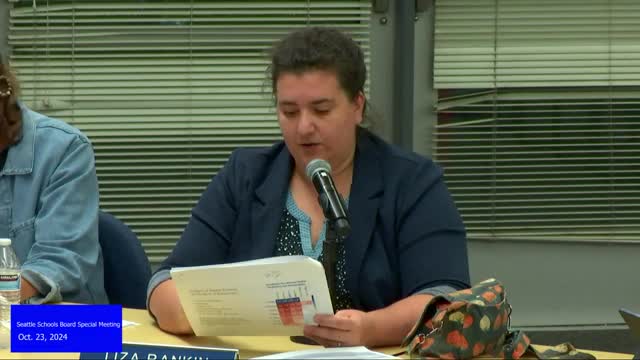Education funding fails to target students in need
October 24, 2024 | Seattle School District No. 1, School Districts, Washington
This article was created by AI summarizing key points discussed. AI makes mistakes, so for full details and context, please refer to the video of the full meeting. Please report any errors so we can fix them. Report an error »

During a recent government meeting, discussions centered on the disparities in educational outcomes among students, particularly focusing on the performance of Black students and those from low-income backgrounds. A key point raised was the need to prioritize support for students who are the furthest from achieving academic goals.
Participants emphasized the importance of directing resources and strategies towards these students, advocating for a targeted approach that considers their specific needs. The conversation highlighted a concerning trend where significant funding is allocated to schools with poor outcomes, often due to a reliance on poverty as a primary indicator for resource distribution.
It was noted that while schools with high poverty rates receive substantial financial support, this does not always translate into improved student performance. In contrast, schools with lower poverty levels often achieve better outcomes despite receiving less funding. This raises questions about the effectiveness of current spending practices and the need for a reevaluation of how educational funds are allocated.
The meeting underscored the necessity for a more strategic approach to educational funding, ensuring that resources are utilized in a manner that directly benefits students who require the most support. Participants called for a reassessment of funding strategies to ensure that financial investments are aligned with the goal of improving educational outcomes for all students, particularly those facing the greatest challenges.
Participants emphasized the importance of directing resources and strategies towards these students, advocating for a targeted approach that considers their specific needs. The conversation highlighted a concerning trend where significant funding is allocated to schools with poor outcomes, often due to a reliance on poverty as a primary indicator for resource distribution.
It was noted that while schools with high poverty rates receive substantial financial support, this does not always translate into improved student performance. In contrast, schools with lower poverty levels often achieve better outcomes despite receiving less funding. This raises questions about the effectiveness of current spending practices and the need for a reevaluation of how educational funds are allocated.
The meeting underscored the necessity for a more strategic approach to educational funding, ensuring that resources are utilized in a manner that directly benefits students who require the most support. Participants called for a reassessment of funding strategies to ensure that financial investments are aligned with the goal of improving educational outcomes for all students, particularly those facing the greatest challenges.
View full meeting
This article is based on a recent meeting—watch the full video and explore the complete transcript for deeper insights into the discussion.
View full meeting
